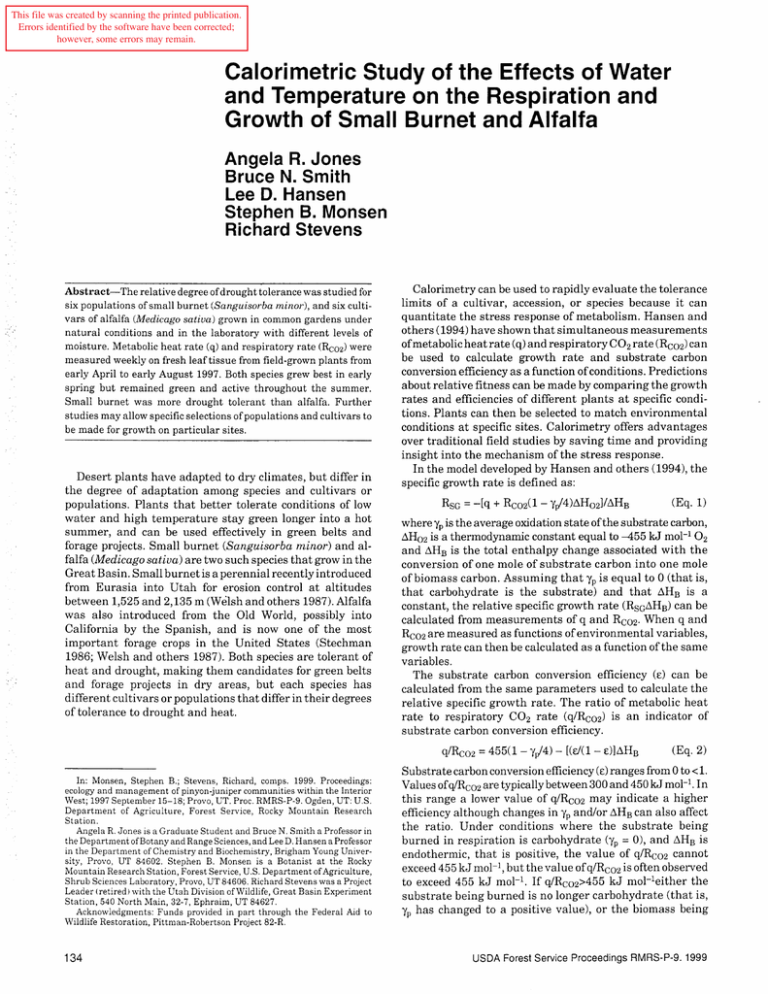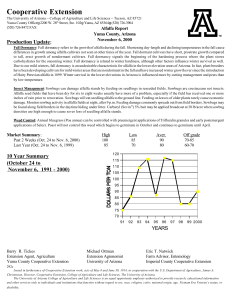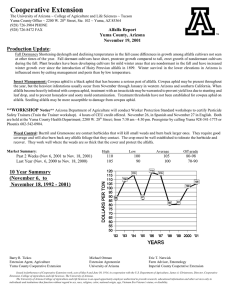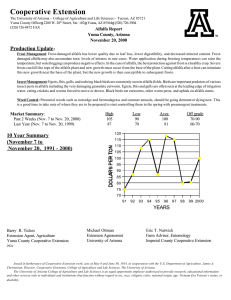Calorimetric Study of the Effects of Water
advertisement

This file was created by scanning the printed publication.
Errors identified by the software have been corrected;
however, some errors may remain.
Calorimetric Study of the Effects of Water
and Temperature on the Respiration and
Growth of Small Burnet and Alfalfa
Angela R. Jones
Bruce N. Smith
Lee D. Hansen
Stephen B. Monsen
Richard Stevens
Abstract-The relative degree of drought tolerance was studied for
six populations of small burnet CSanguisorba minor), and six cultivars of alfalfa (Medicago sativa) grown in common gardens under
natural conditions and in the laboratory with different levels of
moisture. Metabolic heat rate (q) and respiratory rate (RC02) were
measured weekly on fresh leaf tissue from field-grown plants from
early April to early August 1997. Both species grew best in early
spring but remained green and active throughout the summer.
Small burnet was more drought tolerant than alfalfa. Further
studies may allow specific selections of populations and cultivars to
be made for growth on particular sites.
Desert plants have adapted to dry climates, but differ in
the degree of adaptation among species and cultivars or
populations. Plants that better tolerate conditions of low
water and high temperature stay green longer into a hot
summer, and can be used effectively in green belts and
forage projects. Small burnet (Sanguisorba minor) and alfalfa (Medicago sativa) are two such species that grow in the
Great Basin. Small burnet is a perennial recently introduced
from Eurasia into Utah for erosion control at altitudes
between 1,525 and 2,135 m (Welsh and others 1987). Alfalfa
was also introduced from the Old World, possibly into
California by the Spanish, and is now one of the most
important forage crops in the United States (Stechman
1986; Welsh and others 1987). Both species are tolerant of
heat and drought, making them candidates for green belts
and forage projects in dry areas, but each species has
different cultivars or populations that differ in their degrees
of tolerance to drought and heat.
Calorimetry can be used to rapidly evaluate the tolerance
limits of a cultivar, accession, or species because it can
quantitate the stress response of metabolism. Hansen and
others (1994) have shown that simultaneous measurements
of metabolic heat rate (q) and respiratory CO 2rate (RC02 ) can
be used to calculate growth rate and substrate carbon
conversion efficiency as a function of conditions. Predictions
about relative fitness can be made by comparing the growth
rates and efficiencies of different plants at specific conditions. Plants can then be selected to match environmental
conditions at specific sites. Calorimetry offers advantages
over traditional field studies by saving time and providing
insight into the mechanism of the stress response.
In the model developed by Hansen and others (1994), the
specific growth rate is defined as:
(Eq. 1)
whereyp is the average oxidation state ofthe substrate carbon,
~H02 is a thermodynamic constant equal to -455 kJ mol- I O 2
and ~HB is the total enthalpy change associated with the
conversion of one mole of substrate carbon into one mole
of biomass carbon. Assuming that yp is equal to 0 (that is,
that carbohydrate is the substrate) and that ~HB is a
constant, the relative specific growth rate (RsG~HB) can be
calculated from measurements of q and R C02 ' When q and
RC02 are measured as functions of environmental variables,
growth rate can then be calculated as a function of the same
variables.
The substrate carbon conversion efficiency (E) can be
calculated from the same parameters used to calculate the
relative specific growth rate. The ratio of metabolic heat
rate to respiratory CO 2 rate (q/R c02 ) is an indicator of
substrate carbon conversion efficiency.
q/Rc02 = 455(1 - y/4) - [(£1(1-
In: Monsen, Stephen B.; Stevens, Richard, comps. 1999. Proceedings:
ecology and management of pinyon-juniper communities within the Interior
West; 1997 September 15-18; Provo, UT. Proc. RMRS-P-9. Ogden, UT: U.S.
Department of Agriculture, Forest Service, Rocky Mountain Research
Station.
Angela R. Jones is a Graduate Student and Bruce N. Smith a Professor in
the Department of Botany and Range Sciences, and Lee D. Hansen a Professor
in the Department of Chemistry and Biochemistry, Brigham Young University, Provo, UT 84602. Stephen B. Monsen is a Botanist at the Rocky
Mountain Research Station, Forest Service, U.S. Department of Agriculture,
Shrub Sciences Laboratory, Provo, UT 84606. Richard Stevens was a Project
Leader (retired) with the Utah Division of Wildlife, Great Basin Experiment
Station, 540 North Main, 32-7, Ephraim, UT 84627.
Acknowledgments: Funds provided in part through the Federal Aid to
Wildlife Restoration, Pittman-Robertson Project 82-R.
134
E)]~HB
(Eq.2)
Substrate carbon conversion efficiency (E) ranges from 0 to <1.
Val ues of q/RC02 are typically between 300 and 450 kJ mol-I. In
this range a lower value of q/RC02 may indicate a higher
efficiency although changes in yp and/or ~HB can also affect
the ratio. Under conditions where the substrate being
burned in respiration is carbohydrate (yp = 0), and ~HB is
endothermic, that is positive, the value of q/Rc02 cannot
exceed 455 kJ mol-I, but the val ue of q/Rc02 is often observed
to exceed 455 kJ mol-I. If q/Rc02>455 kJ mol-Ieither the
substrate being burned is no longer carbohydrate (that is,
yp has changed to a positive value), or the biomass being
USDA Forest Service Proceedings RMRS-P-9. 1999
produced has changed (that is, i1HB has changed to a negative value), or both. Either option indicates that a change in
the biochemical pathways has occurred, either the substrate
being burned has changed, or the product biomass composition has changed.
Arrhenius plots of metabolic heat rate versus reciprocal
absolute temperature (In(q) vs, T-I ) can be used to describe
the temperature dependence of q over a temperature range.
The temperature coefficient, Il q , is obtained from the slope of
the Arrhenius plot. Likewise, the temperature coefficient of
the respiratory CO 2 rate, IlC02, is the slope of the Arrhenius
plot of the respiration rate versus reciprocal temperature
(In(R co2 ) vs. T-I). Ilq and IlC02 provide physiological data on
the effect of temperature on the metabolism. Differences in
the temperature dependency of q and Rco2 can be used to
predict the effects of temperature on the growth of different
populations or cultivars.
The purpose of this study is to use respiratory heat and
CO 2 rates to select the most drought and heat tolerant
populations of small burnet and cultivars of alfalfa. Criddle
and others (1997) have shown that calorimetry can be used
to rapidly measure metabolic heat rate and respiration rate
at different temperatures.
Methods
Field Experiment
Six populations of small burnet were grown in two common gardens maintained by the Utah Division of Natural
Resources near Ephraim and Nephi, UT. The variety U13 or
Delar is commercially released while the others were
grown from imported seed (Moore 1995): B10 (Yugoslavia),
B28 (Russia), B30 (Spain), B34 (Russia), and B51 (Iran).
Five cultivars of alfalfa-Henry Mt., Nomad, Ranger,
Spreader II, and Ladak 65-were grown in plots in the
garden at Ephraim, UT. Plants in the common gardens grew
on shallow limestone soils and were not irrigated. One
cultivar of alfalfa, Magnum, 'was grown % mile from the
Ephraim common garden in deep soils and was irrigated and
fertilized. Magnum plants were 3 years old and were Medicago sativa, the others were 2 years old and were hybrids of
Medicago sativa and Medicago {alcata.
Young leaf tissue from small burnet was collected once a
week between April 2 and August 7, 1997, and between
April 29 and July 10, 1997 for alfalfa. Samples were kept in
an ice chest or refrigerated until measurements were made.
Calorimetry
Metabolic heat rate and respiratory CO 2 rate were measured with a Hart Scientific model 7707 Differential Scanning Calorimeter operated in isothermal mode (Criddle
and others 1997). Approximately 100 mg fresh weight of
young leaf tissue was used for each measurement. Respiratory CO 2 rates were determined using the method described
in Criddle and others (1997). After measurement of metabolic heat rate, a small vial with 40 III of 0.4 M NaOR was
placed into the calorimeter ampule with the tissue. As the
CO 2 and NaOH react in solution, heat is produced and the
increase in heat rate is proportional to the rate of CO 2
evolution. The heat of reaction for carbonate formation
(-108.5 kJ mol-I) was used to convert the heat rate into the
rate of CO 2 evolution.
Results _ _ _ _ _ _ _ _ _ __
Small 8 urnet
Table 1 lists the flowering and growth data for field-grown
small burnet. U13 and B34 had flowering stems and red
flowers the earliest (May 13) followed by B30 and B51 which
had flowering stems and red flowers on May 19, and then
B10 and B28 which had flowering stems on May 19 and red
flowers on May 27. U13 had the slowest growth while B10
and B34 have slow growth early in the season, but growth
increases in June. B28, B30, and B51 show the greatest
production, with B51 showing the greatest growth early,
maintaining good growth longer.
Both small burnet and alfalfa grow well early in the
spring. During the first portion of the growing season,
respiration rate (R co2 ) and efficiency (E) are high, that is,
q/Rco2 is low (table 2). There were no significant differences in respiratory properties between the populations of
small burnet grown in Nephi and those grown in Ephraim.
Also, the q and Rco2 values obtained did not change with
sampling date except a few days following flower maturation. Therefore all data before and after this ontological
Table 1-Field growth data on small burnet. Early flower is when
flowering stems first appear, mature flowers appear red.
Flowering dates on Ephraim plants, growth descriptions
based on Nephi plants.
Population
Early flower
Mature flower
Growth
Laboratory Experi ment
B51
May 19
May 19
Best growth
early and late
Seeds from five of the populations of small burnet, B10,
B28, B30, B34, and B51, and seven cultivars of alfalfa,
Henry Mt., Nomad, Ranger, Spreader II, Ladak 65, Magnum, and Yellowhead, were planted in sandy loam on laboratory growth carts. Plants were grown with a 13/11 hour
light/dark schedule at a constant 21 cC. At approximately
60 days, plants were subjected to three different watering
regimes. Plants were watered to field capacity, % field
capacity, and % field capacity. Metabolic heat rates and
respiratory CO 2 rates were measured between 70 and 77
days. Measurements were taken on two plants from each
treatment.
B30
May 19
May 19
Good growth early
slows down in June
B10
May 19
May 27
Poor growth early
good late growth
B28
May 19
May 27
Poor growth early
good late growth
B34
May 13
May 13
Poor growth early
fair late growth
U13
May 13
May 13
Poorest growth
early and late
USDA Forest Service Proceedings RMRS-P-9. 1999
135
Table 2-Values for q, RC02 , q/R c02 , and RSG~HB for each population of small burnet at 15 and 25°C early in the season (before late Mayor early
June when a drop in metabolic rates occurred) and late in the season.
Pop.
qat 15°
RC02 at 15°
q/Rc02 at 15°
RSGMiB at 15°
qat 25°
RCo2 at 25°
q/Rc02 at 25°
RSGMiB at 25°
Early in the season
810
828
830
834
851
U13
3.5
3.9
4.0
3.7
4.1
3.8
13.7
14.3
15.4
13.3
14.8
12.6
273
292
267
298
284
313
2.7
2.6
3.0
2.4
2.7
2.0
8.9
9.8
10.0
9.7
10.3
9.4
26.0
27.1
30.4
26.7
28.4
25.6
361
365
348
377
374
380
2.9
2.6
3.8
2.4
2.7
2.2
7.8
7.7
6.5
6.7
7.1
3.8
288
381
412
401
381
510
1.3
0.9
0.4
0.4
0.6
0.0
5.8
6.8
6.2
6.2
7.1
4.5
14.4
14.7
12.4
14.0
15.2
13.5
376
506
525
467
481
442
0.7
-0.1
-0.5
0.1
-0.2
1.7
Late in the season
810
828
830
834
851
U13
2.2
2.6
2.6
2.6
2.6
1.7
event were averaged to obtain two data points, one describing heat and CO 2 rates before the maturation event and one
after. A few days after flowering, in late Mayor early June,
a decrease in metabolic rate occurs (fig. 1) and q/RC02
increases (table 2). Not all populations flowered at the
same time nor was the time-course of metabolism identical
for the populations (table 2). The decrease in metabolic
activity occurred during the week following May 27 for B51,
B30, and B28, but not until the week following June 2 for
BI0 and B34, and the week following June 9 for U13.
While a change from 15 to 25°C increased the respiration rate (R coz ) by about a factor of 2, efficiency decreased
(see q/Rcoz values in table 2). That is, more of the available
16
0
14
+=
CO
'-
a.
Population
J.lq
J.lC02
810
851
U13
830
834
828
8.0
8.1
8.1
8.0
7.8
7.9
7.2
6.2
5.9
5.6
5.5
5.4
metabolic energy was lost as heat and was thus unavailable
for growth at the higher temperature.
The temperature coefficient for heat rate (Il q ) was essentially the same for all populations, while the coefficient for
respiration rate (IlC02) was much higher for BI0 and B51
than for other populations (table 3).
In the laboratory drought experiment differences in metabolism were observed between the low, medium, and high
watering treatments. As shown in table 4, heat rate, respiration rate, efficiency, and predicted growth at 15°C are all
negatively correlated with increasing levels of water. Small
burnet did better at 1fs offield capacity than at higher levels
of watering.
18
c
Table 3-Temperature coefficient of q and RC02 for
different populations of small burnet.
12
en
C1>
a: 10
8
6
0
10
20
30
Days
Figure 1-Schematic of the metabolic change occurring
in small burnet during a few days in late Mayor early
June 1997. Respiration or RC02 in pmol mg- 1s- 1 versus
time in days.
136
40
Table 4-Laboratory drought experiment for small burnet. Data for all populations
pooled. High water treatment is field capacity, medium water treatment
is %field capacity, and low water treatment is %field capacity.
Water
treatment
qat 15°
(jJWmg- 1)
Low
Med
High
2.9
2.4
1.9
RC02 at 15°
(pmol mg- 1s- 1)
9.8
7.0
4.9
q/RC02 at 15°
(kJ mol- 1)
RSGMiB at 15°
(jJWmg- 1 )
305
373
443
1.6
0.8
0.4
USDA Forest Service Proceedings RMRS-P-9. 1999
Table 5-Average values for q, RC02 , q/RC02' and RSGLlHs for cultivars of alfalfa at 15 and 25 °e.
Cultivars
Henry Mt.
Nomad
Magnum
Ranger
Spreader II
Ladak 65
qat 15°
RC02 at 15°
4.0
4.4
6.4
4.6
4.8
4.6
11.5
12.0
18.5
12.7
14.9
13.2
q/Rc02 at 15°
425
411
332
363
333
367
RSGMiB at 15°
qat 25°
0.9
0.6
2.2
1.2
2.0
1.2
10.7
11.4
16.6
11.5
12.1
11.8
Alfalfa
All alfalfa cultivars had a QlO for respiration (R C02 ) greater
than 2 (table 5). Efficiency (q/R c02 ) was better at 15 than
25 °e for four of the cultivars but showed little difference
with temperature for Henry Mt. a-nd Nomad. Predicted
growth (RsGL1H B) was better at 15 °e for all cultivars, except
for Magnum.
The temperature coefficient for heat rate (Il q ), while more
variable for alfalfa cultivars than for small burnet populations, was essentially the same for all cultivars (table 6). By
contrast the temperature coefficient for respiration (IlC02)
showed differences among the cultivars.
Pooled data for all cultivars of alfalfa from the laboratory
drought experiment (table 7) showed no trends with watering treatment.
R Co2 at 25°
q/Rc02 at 25°
0.4
0.7
3.1
0.1
1.5
0.9
433
435
395
470
395
458
23.2
26.5
43.3
25.5
29.5
27.8
RSGMiB at 25°
Table 7-Laboratory drought experiment for alfalfa. Data for all cultivars pooled.
High water treatment is field capacity, medium water treatment is %
field capacity, and low water treatment is Y3 field capacity.
Water
treatment
qat 15°
(JlWmg- 1)
Low
Med
High
3.0
2.6
3.0
RC02 at 15°
(pmol mg-1 s-1)
11.0
6.2
9.0
q/Rc02 at 15°
RSG~B at 15°
(kJ mol-1 )
(JlWmg-1 )
395
453
357
2.0
0.3
1.1
the composition of the biomass being produced. In growing
tissues, rates of catabolism are known to depend on rates of
anabolism. The story is similar for alfalfa (table 5).
At 15 °e the populations of small burnet (table 2) ranked
from highest predicted growth rate (RscL1HB) to lowest were:
B30>B51=B10>B28>B34>U13.
Discussion --------------------------------The spring and summer of 1997 were unusually wet and
cool. It proved to be a poor year to try to assess the effects of
drought in the field. This study should be repeated over
several seasons to gain a true understanding of response in
the field to temperature and soil moisture of populations of
small burnet and cultivars of alfalfa. However, some conclusions can be drawn from this small beginning.
While both small burnet and alfalfa remain green and
active all summer, they both .grow best in the cool, moist
spring months. The decrease in metabolism and growth a
few days after flowering (fig. 1) may signal seed set and
represent a shift from active growth to partial dormancy in
order to survive the usual dry, hot summer months in the
Great Basin. The strategy may be to conserve energy during
the harsh summer months and grow more rapidly during
better, even though cooler, conditions. This can be seen
best with small burnet (table 2). The QlO for respiration
remains the same during the shift from early to late season,
but the respiration rate decreases and q/RC02 increases.
These changes may indicate a shift in efficiency or in biochemical pathways, either in the respiratory substrate, or
Table 6-Temperature coefficients of q and RC02 for
cultivars of alfalfa.
Cultivar
Ilq
IlC02
Nomad
Magnum
Ranger
Henry Mt.
Ladak 65
Spreader"
8.1
8.1
8.7
8.5
8.1
7.9
8.1
7.0
7.0
6.5
6.3
5.3
USDA Forest Service Proceedings RMRS-P-9. 1999
The alfalfa cultivars similarly ranked (table 5) by RSGL1HB
were:
Magnum>Spreader Il>Ranger=Ladak65>Henry Mt.>Nomad.
Conclusions __________
Small burnet and alfalfa have higher relative specific
growth rates and higher efficiency (that is, lower values of
q/Rc02) at 15 than at 25 °e. Thus the rate of energy storage
in structural biomass is faster at lower temperatures.
Populations of small burnet and cultivars of alfalfa that
show a decrease in metabolic rate later in the season will
grow slowly but remain green longer.
Small burnet seems to be more drought-resistant than
alfalfa.
References --------------------------------Criddle, R S.; Smith,B. N.; Hansen, L. D.1997. A Respiration Based
Description of Plant Growth Rate Responses to Temperature.
Planta. 201: 441-445.
Hansen, L. D.; Hopkin, M. S.; Rank, D. R; Anekonda, T. S.;
Breidenbach, R W.; Criddle, R S. 1994. The Relation Between
Plant Growth and Respiration: A Thermodynamic Model. Planta.
194: 77-85.
Moore, K. D. 1995. Effects of Seed Size on Germination and Emergence of Burnet (Sanguisorba) Scop. (Rosaceae) and Variation in
Drought Tolerance Within and Among Ecotypes of Small Burnet
(Sanguisorba minor) Scop. (Rosaceae). Master of Science Thesis.
Brigham Young University. 76 p.
Stechman, J. V. 1986. Common Western Range Plants: Their
Fundamental Structure, Growth, Value and Management. 3rd
ed. California Polytechnic State University Foundation.
Welsh, S. L.; Atwood, N. D.; Goodrich, S.; Higgins, L. C. 1987. A
Utah Flora: Great Basin Naturalist Memoir #9. Brigham Young
University Press.
137






